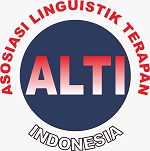Analysis of the Use of Banksy Image in Improving Students’ Writing Skills
DOI:
https://doi.org/10.33394/jollt.v9i4.4005Keywords:
Banksy Image, Teaching Writing, Writing SkillsAbstract
References
Aunurrahman, A., Hamied, F. A., & Emilia, E. (2017). A Joint Construction Practice in an Academic Writing Course in an Indonesian University Context. Celt: A Journal of Culture, English Language Teaching & Literature, 17(1), 27. https://doi.org/10.24167/celt.v17i1.1137
Creswell, J. W. (2012). Educational Research: Planning, Conducting, and Evaluating Quantitative and Qualitative Research (4th ed.). Boston: Pearson.
Faridha, N. (2019). The Effect of Video in Teaching Writing Skill across Different Personality. JEES (Journal of English Educators Society), 4(1), 61. https://doi.org/10.21070/jees.v4i1.1808
Fernández-Dobao, A. (2020). Collaborative writing in mixed classes: What do heritage and second language learners think? Foreign Language Annals, 53(1), 48–68. https://doi.org/10.1111/flan.12446
Haerazi, H., Irawan, L. A., Suadiyatno, T., & Hidayatullah, H. (2020). Triggering Preservice Teachers ’ Writing Skills through Genre-Based Instructional Model Viewed from Creativity. International Journal of Evaluation and Research in Education, 9(1), 234–244. https://doi.org/10.11591/ijere.v9i1.203945
Haerazi, H., & Irawan, L. A. (2020). Developing Intercultural Language Learning (ILL) model to teach writing skills at Indonesian private universities. EduLite: Journal of English Education, Literature and Culture, 5(1), 43. https://doi.org/10.30659/e.5.1.43-54
Ibnian, S. (2010). The Effect of Using the Story-Mapping Technique on Developing Tenth Grade Students’ Short Story Writing Skills in EFL. English Language Teaching.vol 4 (3), 181-194.
Johnson, A. (2008). Teaching Reading and Writing a Guide Book for Tutoring and Remediating the Students. New York, Rowman & Littlefield Education.
Juniarti, K., Sofyan, D., & Kasmaini. (2017). the Effect of Using Graphic Organizer To Students’ Writing Ability. Journal of English Education and Teaching, 1(1), 48–57. https://doi.org/10.33369/jeet.1.1.48-57
Kupers, E., Lehmann-Wermser, A., McPherson, G., & van Geert, P. (2019). Children’s Creativity: A Theoretical Framework and Systematic Review. In Review of Educational Research (Vol. 89, Issue 1). https://doi.org/10.3102/0034654318815707
Lahuerta, A. (2020). Analysis of accuracy in the writing of EFL students enrolled on CLIL and non-CLIL programmes: the impact of grade and gender. Language Learning Journal, 48(2), 121–132. https://doi.org/10.1080/09571736.2017.1303745
Lee, I., Mak, P., & Burns, A. (2015). Bringing Innovation to Conventional Feedback Approaches in EFL Secondary Writing Classrooms. English Teaching: Practice & Critique, 14(2), 140–163. https://doi.org/https://doi.org/10.1108/ETPC-02-2015-0004
Mutiarani, & Saindra, R. M. (2018). Using Graphic Organizer to Improve Students’ Speaking Skills. English Language in Focus (ELIF), 1–10.
Nation. (2009). Teaching Esl/ Efl reading and writing. New york .Routledge.
Setyowati, L., Sukmawa, S., & Latief, M. A. (2017). Solving the Students’ Problems in Writing Argumentative Essay Through the Provision of Planning. Celt: A Journal of Culture, English Language Teaching & Literature, 17(1), 86. https://doi.org/10.24167/celt.v17i1.1140
Sinaga, P., & Feranie, S. (2017). Enhancing critical thinking skills and writing skills through the variation in non-traditional writing task. International Journal of Instruction, 10(2), 69–84. https://doi.org/10.12973/iji.2017.1025a
Sitorus, G. S., & Sipayung, K. (2018). An Error Analysis of Using Phrases in Writing Recount Text at Tenth Grade in SMA Parulian 2 Medan. Celt: A Journal of Culture, English Language Teaching & Literature, 18(1), 74. https://doi.org/10.24167/celt.v18i1.562
Ruegg, R. (2018). The effect of peer and teacher feedback on changes in EFL students’ writing self-efficacy. Language Learning Journal, 46(2), 87–102. https://doi.org/10.1080/09571736.2014.958190
Taylor, G. (2009). A Student Writing Guide How to Plan and Write Succesful Essay.New York. Cambridge.
Downloads
Published
How to Cite
Issue
Section
Citation Check
License
License and Publishing Agreement
In submitting the manuscript to the journal, the authors certify that:
- They are authorized by their co-authors to enter into these arrangements.
- The work described has not been formally published before, except in the form of an abstract or as part of a published lecture, review, thesis, or overlay journal.
- That it is not under consideration for publication elsewhere,
- That its publication has been approved by all the author(s) and by the responsible authorities – tacitly or explicitly – of the institutes where the work has been carried out.
- They secure the right to reproduce any material that has already been published or copyrighted elsewhere.
- They agree to the following license and publishing agreement.
Copyright
Authors who publish with JOLLT Journal of Languages and Language Teaching agree to the following terms:
- Authors retain copyright and grant the journal right of first publication with the work simultaneously licensed under a Creative Commons Attribution License (CC BY-SA 4.0) that allows others to share the work with an acknowledgment of the work's authorship and initial publication in this journal.Â
- Authors are able to enter into separate, additional contractual arrangements for the non-exclusive distribution of the journal's published version of the work (e.g., post it to an institutional repository or publish it in a book), with an acknowledgment of its initial publication in this journal.
- Authors are permitted and encouraged to post their work online (e.g., in institutional repositories or on their website) prior to and during the submission process, as it can lead to productive exchanges, as well as earlier and greater citation of published work.
Licensing for Data Publication
- Open Data Commons Attribution License, http://www.opendatacommons.org/licenses/by/1.0/ (default)
This work is licensed under a Creative Commons Attribution-ShareAlike 4.0 International License.
















